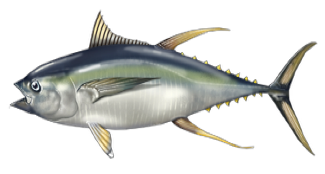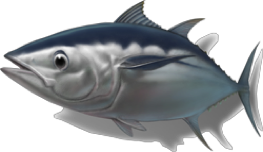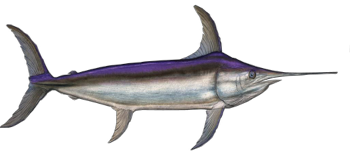WTBF FISHERY
The Western Tuna and Billfish Fishery (WTBF) is, by area, the largest fishery in Australia. It is controlled by the Australian Government, through the “Australian Fisheries Management Authority” (AFMA), who issue fishing authorities and designate the quantities of fish that can be harvested annually.
The WTBF zone extends westward from Cape York Peninsula (142°30’E) off Queensland around the westward coast of Western Australia and from there extends eastward across the Great Australian Bight to 141°E at the South Australian/Victorian border. This includes Australian waters outside out to 200 nm off Christmas Island and Cocos Keeling Islands.
WTBF RESOURCE
The Western Tuna Fishing Zone (WTBF) represents an untapped marine resource that is totally protected under Australian law. The right to harvest fish stocks is tightly controlled by the Australian Government through the issue of a limited number of Fishing Licenses for access, and Catch Quotas to restrict the amount of product harvested annually.
In July 2010, following assessment by the Australia Government, an annual Catch Quota level of 10,125-ton was set on the four main species caught within the WTBF fishery. Thus it has been determined, that the resource is adequate to sustain an annual 10,000-ton harvest.
WTBF TARGET SPECIES
The main fish species licensed to be caught in the WTBF Fishery are:
Yellowfin tuna (Thunnus albacares)
Bigeye tuna (T. obesus)
Albacore tuna (Thunnus alalunga)
Broadbill swordfish (Xiphias gladius)
Striped Marlin (Tetrapturus audax)
WTBF QUOTA TONNAGE
Bigeye Tuna: 2,000-ton
Yellowfin Tuna: 5,000-ton
Broadbill swordfish: 3,000-ton
Striped Marlin: 125-ton
YELLOWFIN TUNA
BROADBILL SWORDFISH



BIGEYE TUNA
TOTAL ALLOWABLE CATCH - TAC
From July 2010 the Australia Government closed the WTBF Fishery by setting “Total Allowable Catch” (TAC) levels of 10,125-ton on the four main species caught within the WTBF fishery.
This process of closing the fishery had been as a result of a general policy shift by the Australian Government towards greater resource management, and further influenced by a decline in fishing activity within the WTBF fishery. The first part of the process was the issue of Statutory Fishing Rights or SFRs to all of the existing participants, and then a lengthy consultation process to determine the initial catch allocation to be awarded to the holders of the SFRs.
After several years of Government process the new legislation came into effect on the 1st of July 2010 allocating a Total Catch of 10,125-ton to the WTBF Fishery. After the allocation was granted, over seventy percent of the existing operators sold out their entitlements.
WTBF CATCH QUOTA
The WTBF is restricted in the amount and species of fish that can be caught through the setting of “Total Allowable Commercial Catch” (TACC) limits. Such limits establish the maximum tonnages that can be harvested each year per species. The TACC limit is determined seasonally by the Australian Government through the Australian Fisheries Management Authority (AFMA) in accordance with the Western Tuna and Billfish Fishery Management Plan 2005 - Part 3 Section 11.
The legal right to conduct commercial fishing activities in, and harvest fish from the WTBF is through the ownership of Statutory Fishing Rights (SFRs) allied with the WTBF.
AFMA controls the WTBF Fishery by setting a TACC limit of 10,125-tons on the four main species that are able to be caught within the WTBF. The initial quota allocation was issued on the 1st July 2010 to the original WTBF SFR holders
The actual annual Catch Quota is calculated in tonnes by multiplying the Statutory Fishing Rights (SFR's) by the pro-rata rate set each year by AFMA.
WTBF TARGET FISHING AREA
The use of Ulta-Low Temperature freezer boats (ULT) enables the targeting of the outer and northern regions of the WTBF zone, that historically have been impossible for Australian boats to fish. These areas are north, around the Cocos and Christmas Islands, and the remote area off the northern Kimberly’s, and south, commencing adjacent to Carnarvon and heading south along the 150-400 nautical mile edge of the zone, from the 25‘South Parallel to around the 35‘South Parallel.
WTBF FISH STOCK
The Fishery is basically comprised of two different fish stocks. If an imaginary line is drawn from Geraldton heading west, then one stock is located south of the line, and the second stock north of the line. The fish species are the same genus, but slightly different in appearance and quality. Although considered to be the same species covered by the zones catch quota, they are in-effect a cold water and a hot water fish species. What this means is that each fish stock is harvested at a different time of the year, and attracts a different market price.
In assessing the resource, and subsequently the initial catch quota to be authorised for the entire zone, the previous three years of catch histories from fishing operators was used as the basis for this calculation. As the majority of catch had traditionally come from the southern fish stocks located close to shore, this resulted in a quota allocation that is representative of only the southern fish stock, and pays no attention to the northern stocks. Thus it is inferred that the southern fish resource is considered adequate to sustain a 10,000-ton harvest annually, and as both stocks are considered by scientists to be of a similar size, it can be assumed that the northern resource will also support a similar 10,000-ton harvest annually.
WESTERN TUNA AND BILLFISH FISHERY

